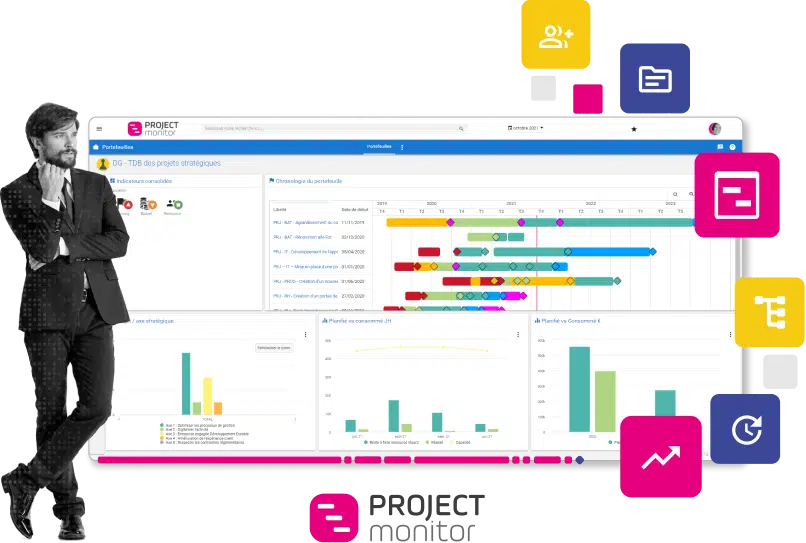How to distribute the workload?
Balanced workload distribution is essential to ensure optimum productivity, avoid overwork and keep human resources motivated. Regardless of the nature of the project, an effective distribution of workloads enables us to manage projects more efficiently and better achieve our objectives.
In this article, we will explore strategies and tips for distributing the workload fairly and wisely:
- Understanding skills, preferences and availability
- Setting priorities
- Encouraging shared responsibility
- Avoid overwork
- Reassess regularly
- Use a project portfolio management tool
5 tips for distributing your project workload
1. Understanding skills, preferences and availability
Before allocating the workload, it's essential to be familiar with the skills and preferences of the members of the resource pool. In addition, you need to agree on the availability of each member, as some people can work full-time, while others can only dedicate 80% of their time. By taking these factors into account, you can allocate projects in such a way that each member can contribute to the maximum of his or her abilities.
2. Setting priorities
Identify the most important and urgent projects. By clearly defining priorities, you can allocate crucial projects first. This ensures that strategic objectives are given priority, while less critical projects can be planned at a later date.
💡 Use the features of project portfolio management software like Project Monitor to align resources with strategic objectives and corporate priorities.
3. Allocate responsibilities
The precise allocation of tasks and responsibilities plays an essential role in the efficient management of teams and projects. Assigning each task to a specific manager not only ensures a balanced distribution of the workload, it also enhances clarity. This approach fosters individual accountability, as each team member knows exactly what his or her responsibilities are, and can focus on completing them successfully. By avoiding confusion and task overlap, this method of task allocation helps to boost overall team productivity, improve coordination and make it easier to monitor and manage progress.
4. Prevent over-staffing
Be careful not to overload some members of your resource pool to the detriment of others. Overwork can lead to reduced productivity, increased stress and health problems. If some members have a heavier workload, make sure you give them adequate recovery periods.
💡 Capacity Planning is a good tool for optimizing team allocation and avoiding team over-staffing. According to a study conducted by the Association for Project Management, poor resource management is the cause of 43% of project failures. Use project portfolio management software to get an overview of all current projects, available resources and their current allocation. The software can help balance workloads by allocating resources fairly and avoiding overloading any one team or individual.
5. Reassess regularly
Needs and priorities change over time. That's why it's essential to regularly reassess workload distribution. If necessary, make adjustments to better meet the changing needs of the project or team.
Use a project portfolio management tool to distribute the workload
Software such as Project Monitor makes it much easier to distribute the workload.
With its resource sheet, capacity plan, Gantt chart and kanban table functionalities, you can easily track deadlines, task progress and overall project progress.
This real-time coordination considerably simplifies resource allocation, enabling better planning and optimal management of activities.
With Project Monitor, you benefit from a complete overview of your projects, enabling smooth team collaboration and informed decision-making to achieve your objectives. Simplify and optimize your resource management today with Project Monitor.
💡 To remember
A balanced workload is crucial to the success of any project. It's a real balancing act, where it's essential to involve the right person at the right time, according to their availability and skills. To achieve this, complete visibility of project needs and resource availability is essential. That's why we strongly recommend Project Monitor, a powerful project portfolio management tool. With Project Monitor, you can simplify this complex task and optimize your resource allocation. Make an appointment with one of our experts to find out more about the software and discover how it can greatly help you manage your projects efficiently and guarantee their success. Don't let load balancing stand in the way of your success - adopt Project Monitor today! Request a demo.
Other frequently asked questions about resource management
How do you calculate the number of resources needed for a project?
Who allocates resources to the project?
What resources are needed to make a project a success?
How do you calculate a project's workload?
How do you smooth out the workload?
How to draw up a successful workload plan to effectively manage project resources?
Project Monitorresource & project portfolio management software
All the tools for resource management (and more). All in one software package.
Discover the features of Project Monitor, resource & project portfolio management software designed to meet the needs of PMOs, CIOstructures with more than 50 employees, or managing complex projects.
Easily manage over 100 active projects and pilot your action plans. Get a complete overview of what's happening in your project portfolio: resources, schedulebudget, dashboards.
